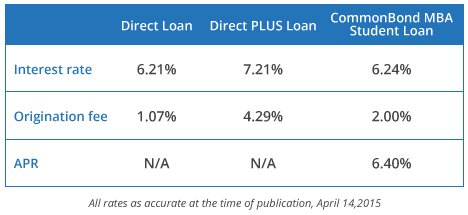The following sponsored content was provided to Clear Admit by CommonBond. For more information about sponsorship opportunities with Clear Admit, contact us here.
First off, congratulations to all the new admits! Whether you’re starting your first year this fall or returning for your second year, you’ll need to answer the following question: How will you pay for the next year of school? If the answer is “all or partially with student loans,” we’ve got you covered with the information you need to make an informed choice on the right loan for your situation. CommonBond is a student lending platform founded by three MBAs who created the company based on their own experiences with the unnecessarily expensive and confusing student loan system. We know the experience can be overwhelming and are here to help, so let’s get started.
If you’re a U.S. citizen or permanent resident, your options are federal student loans and private student loans.
The two key federal loan programs are the Direct Unsubsidized Loan (the “Stafford loan for graduate school”) and the Direct PLUS Loan. You can borrow up to $20,500 annually through the Direct Unsubsidized Loan program. That’s a great foundation to your funding plan given that this loan comes with a fixed interest rate of 6.21% and an origination fee of 1.07% – one of the lowest rates out there. Tuition being what it is these days, however, $20K is unlikely to cut it, so how do you fund the rest? Let’s first consider the second key federal option: Direct PLUS Loans. Rates are presently set at 7.21%, with a 4.29% origination fee, on these loans. Like the Direct Unsubsidized Loans, Direct PLUS Loans come with the government’s broad array of borrower protections – everything from deferment to Income-Based Repayment plans – but at these rates, they are likely not the best deal for MBAs seeking to minimize interest costs.
Private loan programs, managed by private lenders, can vary widely in terms of rates, terms, borrowers protections, customer service, etc. However, the interest rates generally land below the Direct PLUS program, offering a savings option for MBAs who have maxed out their Direct Unsubsidized Loans. At CommonBond, for example, our MBA Student Loan starts at a fixed 6.24% rate (6.40% APR), when the borrower elects to make automatic payments. (That 6.40% APR, which private lenders are required to disclose in order to help borrowers make apples-to-apples comparisons among private loans, includes a 2% origination fee.)
Here’s a table comparing three options:
Note for international students studying in the U.S.: Securing loans can be a challenge, and often your best resource is your school’s financial aid office. They’ve pretty much seen it all before and can share the experiences of other recent students to help you find the best financing option for you. Many programs even maintain a special agreement with a U.S. credit union or bank to help their international MBAs, which could mean lower rates on your loans than other private lenders offer.
The bottom line for MBAs looking for student loans? There are tradeoffs to federal and private loan options, but a mix of both can be the best bet for MBAs looking for the best deal. If you have any loan or financing questions, feel free to contact our friendly Care Team at [email protected]. They’ll be happy to walk you through your options. For more information on borrowing through CommonBond, check out our MBA Student Loans. Finally, if you’re making your budget for next year, we have an automated MBA Budget Calculator with all the inputs you need to budget for the next two years.





